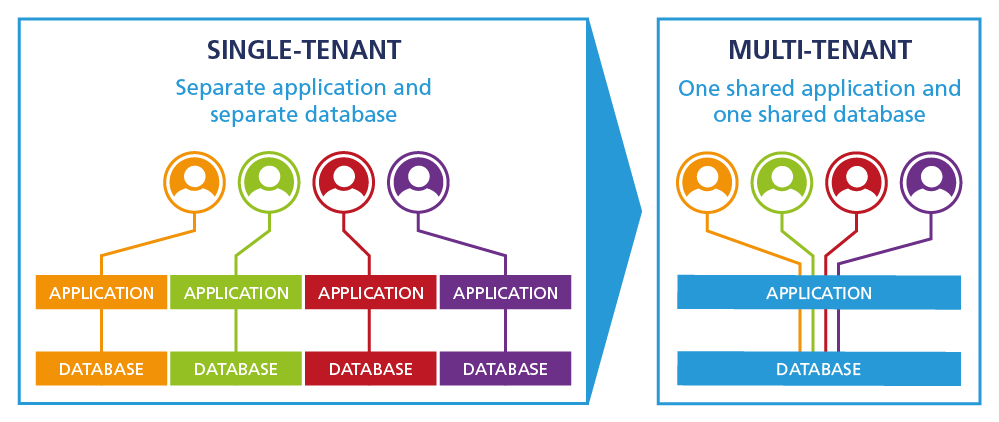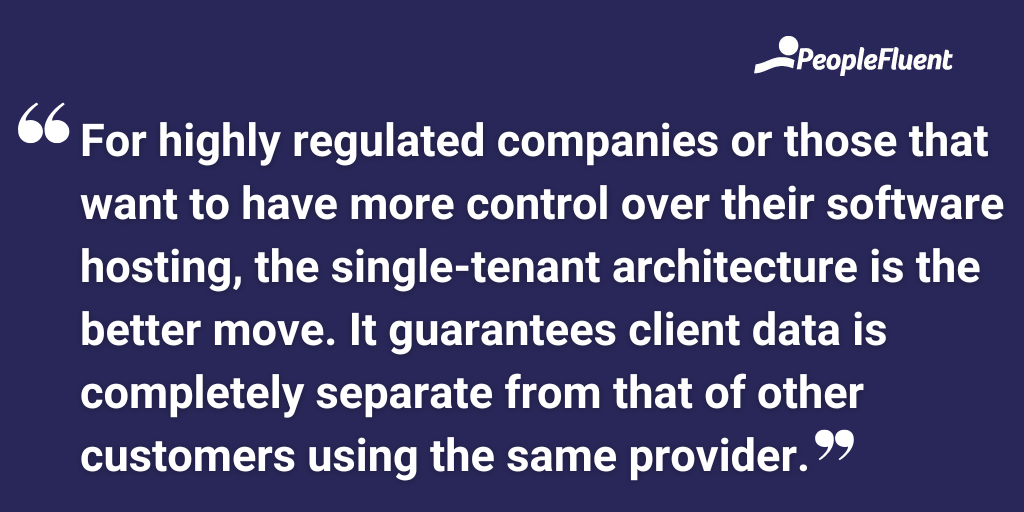Published: May 5, 2023Time to read: 4mins Category: Learning
Single Tenant vs. Multi-Tenant Software: Is On-Premise LMS Hosting Right for Your Business?
When it’s time to upgrade your corporate learning software, it’s wise to investigate the real estate and terrain each provider offers. Just as all people have different needs and expectations when it comes to the place we call “home,” each organization has unique needs for how it houses its learning programs.
Much like brick-and-mortar construction, the process of configuring software architecture starts with careful planning. For most organizations, it becomes prohibitively expensive to alter blueprints once basic elements are in place. A good place to start in choosing your LMS is deciding between a multi-tenant or a single-tenant LMS solution.
Single-Tenant vs. Multi-Tenant: Which Host Does the Most?
Don’t let the names fool you: “single” and “multi” are not prefaces that refer to the number of advantages each network architecture comes with! Both learning solutions can serve businesses well and are scalable, but they have distinct differences in how they manage and store data.
A multi-tenant LMS is like living in an apartment complex. Each tenant has access to the building lobby, but individuals have keys to their specific apartments. Everyone has a private living space within the same home base. Multi-tenant LMSs work the same way. Many companies store their data in the same, shared place, but each company has its own designated area to store its data within that shared network.
Multi-tenant learning solutions can work well for many organizations, but they may not be the first choice for companies looking for the highest assurance that their data won’t be breached. With multi-tenant software, you’re tapping into the same database as other customers of your selected solutions provider.
On the other hand, a single-tenant LMS is like owning a single-family home. The LMS provider ensures each customer has their own instance of the software. When you implement a single-tenant LMS, you can build your own supporting architecture around it.
Unlike a single unit in an apartment complex, a standalone house allows for more personalization options. Similarly, single-tenant LMS users can configure the solution around the software to accommodate their environment. Users of a single-tenant LMS will also have more control over when they get upgrades and they’ll likely have more influence over the nature and scheduling of the vendor’s roadmap.

On-Premise or Off-Premise Learning Software Hosting?
When you’re searching for an LMS provider to meet your organization’s needs, a crucial point to consider is whether or not the software will be hosted on-premise. While both software options incorporate security features, they differ in how those features are implemented.
A multi-tenant LMS is often hosted off-premise. The LMS provider manages the hosting themselves, which can be a good option for organizations that don’t require or desire as much control over their learning software.
Single-tenant software is often hosted on-premise. This is a great choice for organizations that want to manage their own hosting. It’s also appealing to companies in highly-regulated industries because on-premise hosting allows organizations to deploy learning software in their own servers or private cloud. This eliminates the risk of co-mingling data with other companies. On-premise hosting also makes it possible for businesses to use firewalls and implement other security features that may be limited in a multi-tenant LMS.

READ MORE ON EMPLOYEE LEARNING | ‘How a Modern Learning Strategy Is Essential to Your Future Training Efforts’
Which Is the Right LMS Solution?
Ultimately, the learning software you choose will depend on your company’s needs. Multi-tenant systems can be a solid choice for organizations with minimal security concerns or those that don’t want to play as active a role in their hosting.
For highly regulated companies or those that want to have more control over their software hosting, the single-tenant architecture is the better move. It guarantees client data is completely separate from that of other customers using the same provider. Single-tenant solutions also allow organizations to implement their own rigorous security measures.
When considering your organization’s learning needs, ask yourself whether you’re renting an apartment or buying a home.
JUST FOR YOU | ‘4 Ways PeopleFluent Learning Helps Organizations in Highly Regulated Industries’
Note: This article was first published in 2018 and has since been updated with recent information.
Customize Your Learning With On-Premise LMS Hosting
Design, deploy, track, analyze, and report on enterprise learning and compliance programs. PeopleFluent helps you execute your programs seamlessly while keeping you in control, so employees upgrade their skills while you get results.